Indian costume

India is a country with an ancient history. India has been mentioned as far back as several thousand years before our era. And all this time, the Indian people have preserved and protected their culture and traditions.

Indian culture is distinguished by its great originality and originality. In the process of development, the ancient Indians mastered various crafts that were passed down from generation to generation, which contributed to the achievement of the highest skill in each of them.

India is a very large state, and moving from one region to another, one never ceases to wonder how the way of life and traditions among the indigenous population of this mysterious country is changing. This diversity is reflected in the creation of traditional Indian costumes.

The unique color, variety of patterns, uniqueness and beauty of Indian clothing made it the most recognizable in the world. A woman of India, dressed in the national dress, strikes the eye with her irresistibility and beauty, however, she is not devoid of modesty and chastity.


Just as traditions are varied in different regions of the country, so the suit differs in its color, cut, pattern and style of wearing. However, despite all the versatility, the national dress retained common recognizable features.

The history of traditional women's clothing dates back to ancient India. There is no unequivocal opinion of historians about the stages of creating a traditional outfit. But they all agree that it began with long cuts of fabric, draped around the figure in various ways.

Such layering seems inconvenient only at first glance.In fact, the numerous folds formed during the winding of the canvas do not hinder movement and protect well from the high humidity and summer heat of this area.

This layering has survived to this day, but has acquired new forms and options, creating a modern traditional Indian costume.
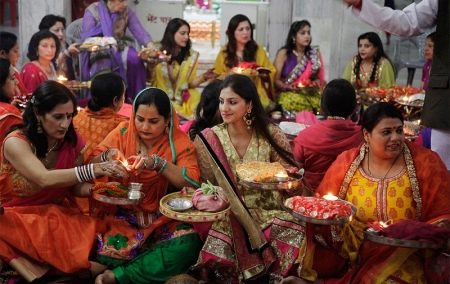
Clothes in India were made exclusively from natural fabrics: linen, cotton, wool. Back in Ancient India, local craftsmen mastered the art of producing natural silk, along with Ancient China. And in the north of the country, in the province of Kashmir, the world-famous Kashmir shawls from the wool of high-mountain goats were spinning.

The Kashmiri shawl is a work of art by local craftswomen. The wool used for its production was thinner than human hair, which gave the product an unprecedented lightness and airiness. This shawl was of the highest value and was often presented as a gift to the queens of different countries.
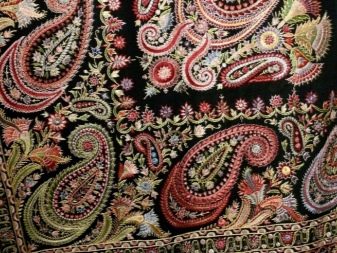


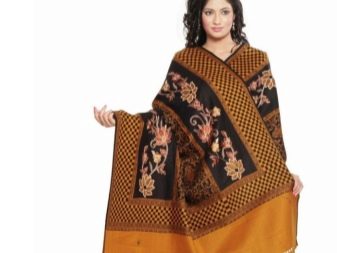
The special pride of the Indians is the art of dyeing fabrics. Only natural dyes were used, and the skill of the Indians was legendary. It was believed that local colorists could distinguish up to six shades of white and up to twelve shades of black. It is partly due to this art that women's clothing in India is so striking in the variety of colors.


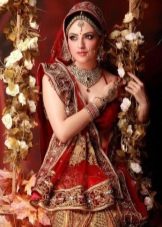

In addition to bright colors, Indian women's clothing uses a rich painting of fabrics, widespread use of embroidery, ribbons, and beads. Embroidery with gold and silver threads is especially popular. Such embroidered and richly decorated fabrics immediately create a unique flavor of Indian costume.



Varieties of women's traditional dress
Sari
It is the most famous Indian womenswear, recognized all over the world. The sari, thanks to its thin material and skillful drapery, makes the figure very feminine and graceful, and the silhouette graceful.


The sari is made of a very long thin cloth (4–9 meters), which is expertly wrapped around the woman's waist, and one end is slung over the shoulder and down to the chest. In different regions of the country, the winding technique and the names of the sarees differ slightly. But everywhere it is very popular clothing, the history of which goes back more than one thousand years.




Casual options are made from cotton or linen fabrics and lack rich embellishments. A festive sari is always made of silk, cambric or muslin, decorated with painting and embroidery.
Since the sari is always decorated by hand, it is impossible to find two identical options.




The wedding sari is ordered from the masters who come up with their own unique pattern for each bride, which is why each bride has her own individual outfit.





In ancient India, fabrics for these clothes were woven exclusively by men. Due to the intricate design and decoration, its production could take up to six months.
A petticoat and choli can be worn under a sari.

Choli
This is a traditional short-sleeved blouse that covers the chest and slightly reveals the girl's belly. Choli is very popular not only in a set with a sari, but also with other types of national costume.


In modern times, choli can have various cut options. You can find a blouse with long sleeves or without sleeves, with thin or thick straps.
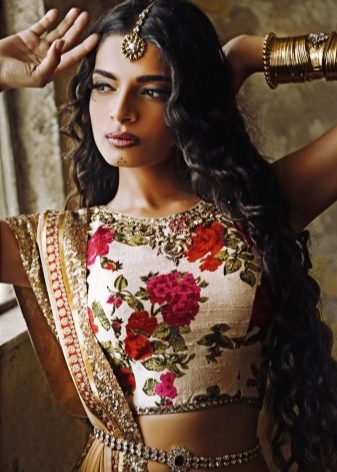

Lehenga-choli
This is another very popular type of Indian costume. It consists of three parts and includes lehenda (lengu), choli and dupattu.


Lenga is a skirt of various lengths, which is cut like an umbrella. By the length of the lengi, it was possible to determine the status of the woman. High-caste Indian women have always worn only long skirts that cover their ankles.


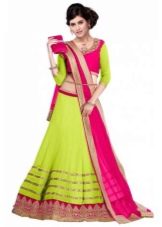

Dupatta is a light, airy cape that covered both the head and shoulders. If earlier only Indian women of the highest castes could afford dupattu, now it is an indispensable attribute of the costume of any Indian woman.

Festive and everyday lehenga-choli differ in material and an abundance of decorations and murals. For everyday use cotton or linen fabrics, for festive brocade, velvet, silk, satin or chiffon.

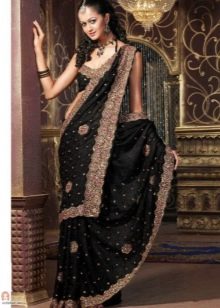

The lehenga-choli gained particular popularity after Ashwarya Rai appeared in a beauty contest in such a national dress.


Shalwar Kameez
The outfit is most popular in the Punjab area. Shalvars (salvars) are wide trousers, narrowed to the bottom. Kamiz is a fitted tunic with slits on both sides. Shalwar kamikh is often complemented by a dupatta cape.

This outfit is especially preferred by modern youth. And also, this model is often used by European fashion designers to create Western clothes in the East Indian style.
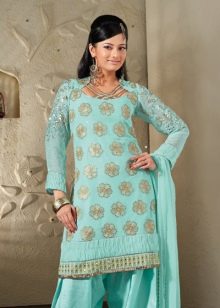


Churidar-kurta
Another type of outfit, consisting of trousers and a tunic... But unlike the salwar, the churidar are tight trousers that are twice as long as the legs. Because of this, they gather on the shins in numerous folds. These pants are worn with a long shirt that reaches the knee, called a kurta.
Churidar can also be combined with kamiz.
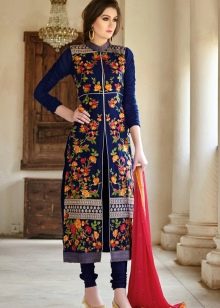


Patiala
These are very wide trousers that are draped at the waist in numerous folds. They are also worn with kameez.


Anarkali
This outfit consists of anarkali dress, churidar trousers and is complemented by a dupatta. Anarkali is no longer a tunic, but a full-length dress, the length of which can vary from knee to floor. The dress fits the figure to the waist, and then flares. Such a suit is widely used in everyday life and at special occasions.

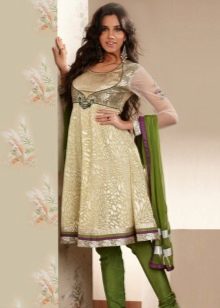

Mundum-neryathum
This is the oldest version of the traditional Indian woman's costume. It is the first type of saree. It differs from the modern sari in that it completely covers the woman's body, including both the belly and the chest. At the same time, the shoulders remain open.
Choli is not worn with mundum-neryatkhum.

Mekkhela-chador
Traditional dress for the inhabitants of the province of Assam. This is the most complex type of dress, consisting of three components: mekhela, sadora (chadora) and rihi. All parts are put on each other, skillfully draped into folds on the right side. Riha, which is a very tight dress, completes the outfit and is worn on top.
Mekkhela Chador is most often used in festive or ritual ceremonies.




Children's national costume is not as diverse as an adult. Little girls wear pattu padawai. It is a long, toe-length dress with a strip of gold thread at the bottom.
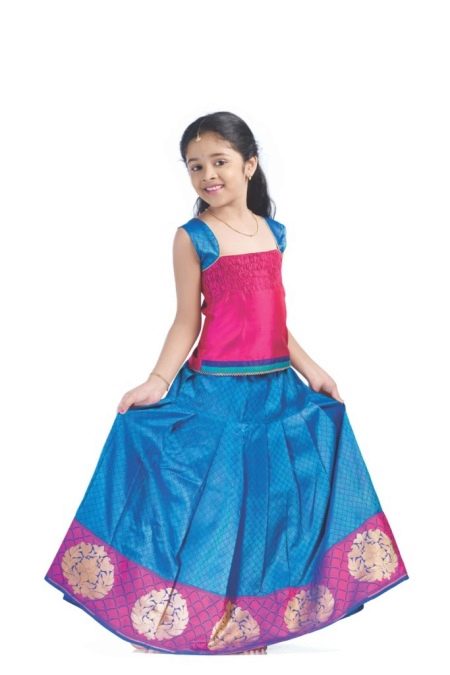
Teenage girls are more likely to wear semi-saree. It consists of lengi (skirt), choli (short blouse) and stole, which is wrapped like a sari.
Children wear such traditional outfits mainly during festive events.

The jewelry of an Indian woman is a matter of national pride. The works of art created by Indian jewelers have been famous for 4 thousand years. Each element in a piece of jewelry carries a deep meaning, not just a decorative function.




The traditional Indian set consisted of 16 types of jewelry. For each part of the body, their own unique options were invented. Bracelets, rings, rings, necklaces, necklaces are only a small part of the abundance that Indian craftsmen have created and continue to create.

In modern India, traditional costume is mixed with modern western clothing. More and more often you can find a woman in jeans and kameez. Sarees are paired with regular T-shirts. But to this day, it is not customary to demonstrate open legs or chest here. After all, India is an eastern country where traditions and religion have a very large impact.









